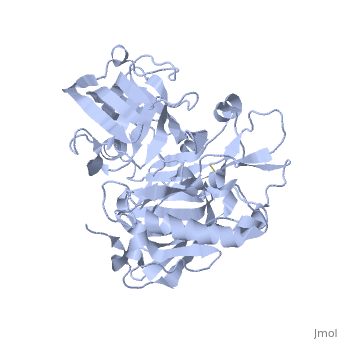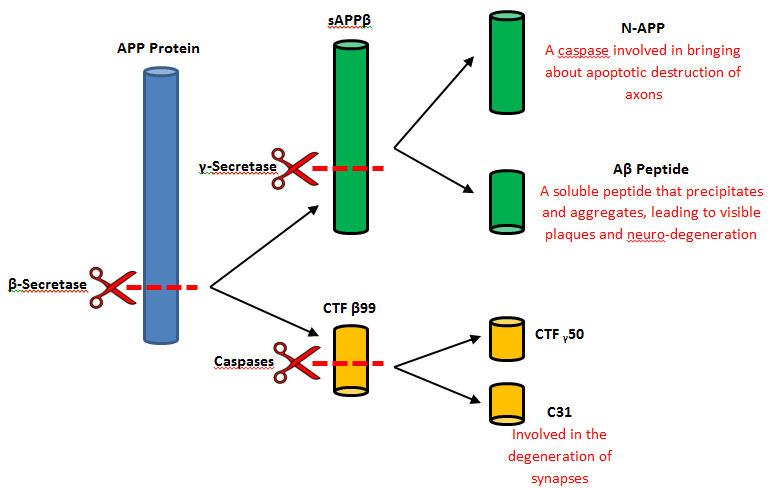Beta Secretase (BACE1) 1SGZ
From Proteopedia
| Line 49: | Line 49: | ||
---- | ---- | ||
=== Alzheimer's Disease === | === Alzheimer's Disease === | ||
| - | Alzheimer’s disease (AD) is an unfortunate neurodegenerative disease that degrades the nervous system, specifically the destruction of neurons in the brain. The brain mass of a person with this disease is significantly reduced over time as brain neurons and brain function diminishes over time. The amyloid plaque, a product of APP, is what aggregates in the brain and degrades neuron function in the brain. The loss of neuron function and inability to make synapses in the brain eventually leads to dementia in AD patients which reduces the patient’s memory. The reduction of memory results in brain capacity reduced, impacting the functioning of the patient’s normal daily life routines and eventually results in death. In the later stages of AD, when brain capacity and function is very low, typically the patient needs to be cared for because they are not able to live their normal life and care for themselves on a daily basis as a normal person would. | + | Alzheimer’s disease (AD) is an unfortunate neurodegenerative disease that degrades the nervous system, specifically the destruction of neurons in the brain. The brain mass of a person with this disease is significantly reduced over time as brain neurons and brain function diminishes over time. The amyloid plaque, a product of APP, is what aggregates in the brain and degrades neuron function in the brain. The loss of neuron function and inability to make synapses in the brain eventually leads to dementia in AD patients which reduces the patient’s memory. The reduction of memory results in brain capacity reduced, impacting the functioning of the patient’s normal daily life routines and eventually results in death. In the later stages of AD, when brain capacity and function is very low, typically the patient needs to be cared for because they are not able to live their normal life and care for themselves on a daily basis as a normal person would<ref name="thirteen">Vasser, R. The B-Secretase Enzyme in Alzheimer’s Disease. Journal of Molecular Neurosceince. 2004, 23, 105-113. http://link.springer.com/article/10.1385/JMN:23:1-2:105</ref> . |
AD occurs because of plaques which are formed from a buildup of amyloid beta. Amyloid beta (AB) is a four kilodalton protein made up of about 39-43 amino acids in length, which aggregates in the brain and causes the destruction of the brain. Amyloid beta is cleaved from the membrane protein APP done so by two proteases, beta-secretase and gamma-secretase. Amyloid betas are amphiphilic peptides with a hydrophilic (water loving) N-terminal side (residues 1-28) and a hydrophobic (water hating) C-terminal side (residues 29-40). These characteristics of the AB is what affects the toxicity of the peptide aggregates in the brain. | AD occurs because of plaques which are formed from a buildup of amyloid beta. Amyloid beta (AB) is a four kilodalton protein made up of about 39-43 amino acids in length, which aggregates in the brain and causes the destruction of the brain. Amyloid beta is cleaved from the membrane protein APP done so by two proteases, beta-secretase and gamma-secretase. Amyloid betas are amphiphilic peptides with a hydrophilic (water loving) N-terminal side (residues 1-28) and a hydrophobic (water hating) C-terminal side (residues 29-40). These characteristics of the AB is what affects the toxicity of the peptide aggregates in the brain. | ||
Revision as of 03:05, 13 April 2016
Beta-secretase, also known as BACE or Memapsin 2, is encoded by the gene BACE1. Beta-secretase is a proteolytic, transmembrane enzyme with two active sites on the extracellular region. It is associated with processing amyloid precursor protein (APP), which is an integral membrane protein.[1] A malfunction in the processing of APP results in the formation of the peptide amyloid beta. Amyloid-beta is a neurotoxic peptide segment that aggregates into plaques. These plaques are the primary component of plaques found in individuals with Alzheimers Disease. [2] Other biological associations of this enzyme include modulating myelination in the central and peripheral nervous systems.[3]
Enzyme Class
Beta-secretase is an enzyme that is classified as a class 3 enzyme, which are hydrolases [4]. The enzyme acts on breaking peptide bonds and therefore is also considered a peptidase and belongs to the subclass of aspartic acid endopeptidases.[5]
Structure
| |||||||||||
References
- ↑ Ghosh, A.; Kumaragurubaran, N.; Hong, L.; Koelsh, G.; Tang, J. Memapsin 2 (Beta-Secretase) Inhibitors: Drug Development. CAR Current Alzheimer Research. [Online] 2008, 5, 121–131. http://jamesmadisonva.library.ingentaconnect.com/content/ben/car/2008/00000005/00000002/art00004
- ↑ 2.0 2.1 2.2 John, V.; Beck, J. P.; Bienkowski, M. J.; Sinha, S.; Heinrikson, R. L. Human β-Secretase (BACE) And BACE Inhibitors. ChemInform. [Online] 2004, 35, 4625-4630. http://pubs.acs.org/doi/pdf/10.1021/jm030247h
- ↑ Hu, X.; Hicks, C. W.; He, W.; Wong, P.; Macklin, W. B.; Trapp, B. D.; Yan, R. Bace1 Modulates Myelination in the Central and Peripheral Nervous System. Nature Neuroscience Nat Neurosci. [Online] 2006, 9, 1520–1525. http://www.nature.com/neuro/journal/v9/n12/abs/nn1797.html
- ↑ Nomenclature Committee of the International Union of Biochemistry and Molecular Biology. The Enzyme List Class 3 — Hydrolases. http://www.enzyme-database.org/downloads/ec3.pdf
- ↑ DBGET Search. KEGG ENZYME: 3.4.23.46. http://www.genome.jp/dbget-bin/www_bget?ec:3.4.23.46
- ↑ 6.0 6.1 6.2 Venugopal, C.; Demos, C. M.; Rao, K. S. J.; Pappolla, M. A.; Sambamurti, K. Beta-secretase: Structure, Function, and Evolution. CNS & Neurological Disorders Drug Targets. [Online] 2008. 7(3), 278–294. http://www.ncbi.nlm.nih.gov/pmc/articles/PMC2921875/
- ↑ 7.0 7.1 7.2 Shimizu, H.; Tosaki, A.; Kaneko, K.; Hisano, T.; Sakurai, T.; Nukina, N. Crystal Structure of an Active Form of BACE1, an Enzyme Responsible for Amyloid Beta Protein Production. Molecular and Cellular Biology [Online] 2008, 28(11), 3663-671. http://mcb.asm.org/content/28/11/3663.full.pdf+html
- ↑ Kumalo, M.; Soumendranath B.; Soliman, M. E. Investigation of Flap Flexibility of β-secretase Using Molecular Dynamic Simulations. Journal of Biomolecular Structure and Dynamics [Online] , 2015, 1-12. http://www.tandfonline.com/doi/full/10.1080/07391102.2015.1064831
- ↑ 9.0 9.1 9.2 Golub, M. (Producer) & Golub, M. (Director). (2015). Youtube. United States: University of Rochester Introductory Biochemistry
- ↑ 10.0 10.1 Manada, N., Tanokashira, D., Hoska, A., Kametani, F., Tamoka, A,. and Araki, W. (2015). Amyloid beta-protein oligomers upregulate the beta-secretase, BACE1, through a post-translational mechanism involving its altered subcellular distribution in neurons. Molecular Brain, Vol. 8, p.1-12. 12p. doi: 10.1186/s13041-015-0163-5
- ↑ Sugana, K., Padlan E., Smith, C., Carlson, W., and Davis, D. (1987). Retrieved April 5, 2016 from

- ↑ JCSciphile, March - Beta-Secretase, 2014, Web, Retrieved April 5, 2016 from http://jcsciphile.com/molecule-of-the-month/march-beta-secretase/
- ↑ Vasser, R. The B-Secretase Enzyme in Alzheimer’s Disease. Journal of Molecular Neurosceince. 2004, 23, 105-113. http://link.springer.com/article/10.1385/JMN:23:1-2:105



